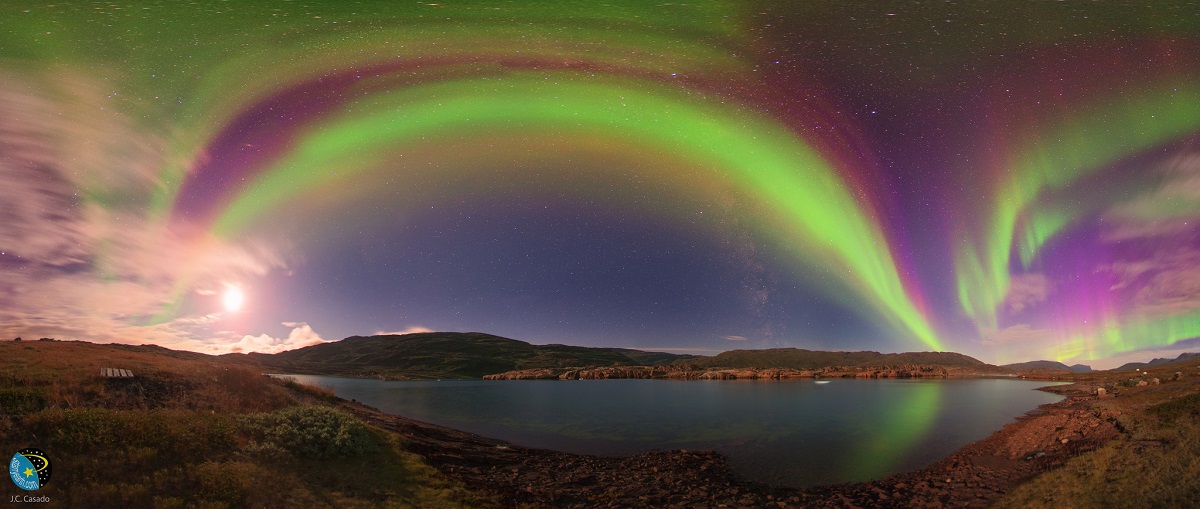BIG DATA
GLORIA carries Northern Lights live from Greenland to Iceland

CESGA is providing the infrastructure for the live broadcast of this science initiative.
The researcher of the Institute of Astrophysics of Canary Miquel Serra-Ricart coordinates the expedition to observe the phenomenon of the Northern Lights from southern Greenland and Iceland from August 23 to 28.
The IAC and the European project GLORIA (GLObal Robotic-telescopes Intelligent Array, Global Network of Robotic Telescopes) will carry the live broadcasts of the phenomenon. The proposal also includes GLORIA image sharing and educational activities for students.
Several Spanish institutions will collaborate in relaying. The Army Command Canary deploy the satellite system for communications in Greenland. Three supercomputing centers (CETA, CESGA and CSUC) replicate the portal of re-transmission. The Spanish Foundation for Science and Technology FECYT, also contributes to the educational proposal.
Only from the polar regions of our planet's polar auroras, a spectacular astronomical phenomenon that appears to our eyes as light curtains and changing various shades are observed. But this summer brings the opportunity to see the Northern Lights (those who are in the northern hemisphere) live from home with an Internet connection. The time is ripe for observation: today the sun shows high activity that produces the auroras due to solar peak earlier this year.
GLORIA is an innovative and ambitious citizen science project that will give free access to a network of robotic telescopes via a Web interface (users.gloria-project.eu). The IAC participates in the project through the Open Telescope Disclosure (TAD).
From August 23 to 29 the expedition Shelios coordinated by the researcher at the Institute of Astrophysics of the Canary Islands (IAC) Miquel Serra-Ricart, you will see the Northern Lights from southern Greenland and Iceland. "The Sun continues to show signs of high activity since reaching its peak earlier this year. If we observe auroral must seize the coming months as there is evidence to make us think that the next solar maximum, in eleven years will be less intense than the actual" said Serra-Ricart.
Members of the European project GLORIA will join the expedition for a live broadcast of the phenomenon. Videos and pictures of the aurora will be broadcast live on the internet (in the portal sky-live.tv) from Greenland and Iceland.
Webcasts
A daily connection will be made, whenever weather conditions permit, from two different locations, Greenland and Iceland.
GREENLAND. The days between August 23 and 25, 2014 (1:00 to 1:30 UT, 23:00 to 23:30 local time yesterday in Greenland, 03: 00-03: 30 CEST, where UT stands for Universal Time and EST Central European Time) will be broadcast from three locations in southern Greenland. The first site is located around the glacier Qaleraliq (length = 46.6791W; latitude = 60.9896N) the second in a farm Tasiusaq and third in the town of Qasiarsuk (Leif Eriksson Hostel, see route map).
ICELAND. The second location is Iceland, the days between 26 and 28 August 2014 (23:30 to 24:00 UT same local time in Iceland, and 01: 30-02: 00 CEST).
The transmission will take place at two levels:
1) Direct Connections. For an hour a camera (Canon 5D-MII) will point to the sky in order to transmit a video sequence of movements in real time, Aurora.
2) Time-Lapse. Every night for an hour and every minute image of the starry sky to keep the portal updated emission will change. To obtain images two Canon 5D Mark II (color) cameras with identical lenses (at least 1km apart and a maximum of 50km) will be used. These images will be accessible (via web) in order to make the proposed educational activity.
The broadcasts can be followed on the portal sky-live.tv. In the same portal updated both the weather and the realization or not of the retransmission information is displayed. The broadcasts will also be announced, with a few hours in advance, the social networks of GLORIA and IAC.
The phenomenon of the Polar Auroras
This wonderful celestial event occurs when energetic particles originating from the Sun (solar wind) reach the earth's atmosphere. The entry of these particles is governed by the Earth's magnetic field and, therefore, can only penetrate the North (Northern Lights) Southern (Southern Lights) and polo. Auroras are formed by huge bright, rapidly changing and various shades curtains. The light emission is produced in upper atmosphere (between 100 and 400 km) and is due to the shock of the solar wind (mainly electrons) with oxygen atoms (green tones) or nitrogen molecules (red tones).
GLORIA is a Citizen Science project with which astronomy is to investigate leveraging the collective intelligence of the community. To do this you will be given opportunity to all Internet users to collaborate. Right now users can contribute in the calculation of solar activity by images of the solar surface (photosphere) obtained with the telescopes of the network. In the coming months, new events occur and interesting news GLORIA. Follow us on our social networks and our (http://gloria-project.eu) website which inform you promptly of all developments.
Robotic telescopes Intelligent Array GLObal for e-Science (GLORIA) is a project funded by the European Union Seventh Framework Programme (FP7 / 2007-2012) under grant agreement 283783. The project is coordinated by the Universidad Politécnica de Madrid and participate 13 partners (UPM, ASU-CAS, CSIC, CTU, FZU-CAS, IAC, INAF, SAO, UCD, UCH, UMA, UOX, UWAR) from eight countries (Spain, Czech Republic, Italy, Russia, Ireland, United Kingdom , Poland and Chile).
The FECYT (Spanish Foundation for Science and Technology, Ministry of Science and Innovation) works in broadcasting within the project "Citizen Astronomy II" of the call for aid for the promotion of scientific culture 2013 (FCT-13-6340) .
The Army, Command Canarias (Ministry of Defence), are working with satellite communications in relaying from Greenland.
Three Spanish supercomputing centers CETA-CIEMAT (Centre for Advanced Technologies Extremadura), CSUC (Serveis Consortium of University of Catalonia) and CESGA (Supercomputing Center of Galicia) collaborate in the distribution web portal retransmission (sky-live.tv).
